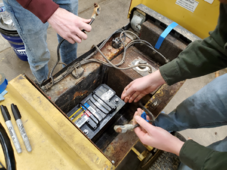Elec-Trakker
New Member
Greetings,
I seek your DIY battery pack wisdom for a project of mine. Not a solar bank, but rather a 1972 GE Elec-Trak E12M. I scored this little guy a few weeks ago and am excited to revitalize it for mowing this summer. While it’s in overall good condition, the batteries are long gone so I need to source replacements. At first, I was going to buy new GC2 batteries, but the cost of LiFePo4 batteries on eBay and Amazon has come down so much I'm tempted to try those for better performance and easier off-season storage.
These tractors originally used six 6-volt GC2 lead-acid golf cart batteries in series for a total of 36 V. The main drive motor is rated for 1.2 HP while the three mower deck motors are about 1/3 to ½ HP each. Current draw specs were never officially published, but based on GE’s claim that these can mow two acres on a charge and GC2s having a 215 Ahr rating, I estimate it will draw about 60-80 A while mowing, spiking above 100 when hitting thick grass or climbing a hill.
After some initial research, I’ve narrowed down my options to these two:
Based on your experience with high-draw battery banks:
Elec-Trakker
I seek your DIY battery pack wisdom for a project of mine. Not a solar bank, but rather a 1972 GE Elec-Trak E12M. I scored this little guy a few weeks ago and am excited to revitalize it for mowing this summer. While it’s in overall good condition, the batteries are long gone so I need to source replacements. At first, I was going to buy new GC2 batteries, but the cost of LiFePo4 batteries on eBay and Amazon has come down so much I'm tempted to try those for better performance and easier off-season storage.
These tractors originally used six 6-volt GC2 lead-acid golf cart batteries in series for a total of 36 V. The main drive motor is rated for 1.2 HP while the three mower deck motors are about 1/3 to ½ HP each. Current draw specs were never officially published, but based on GE’s claim that these can mow two acres on a charge and GC2s having a 215 Ahr rating, I estimate it will draw about 60-80 A while mowing, spiking above 100 when hitting thick grass or climbing a hill.
After some initial research, I’ve narrowed down my options to these two:
- Buy three 12V 200 Ah DC House batteries and wire them in series. DC House’s advertising on Amazon and eBay claims they can support 170 A discharge.
- Buy six 12V 100 Ah DJLBERMPW batteries and wire them in a 2p3s arrangement. I emailed DJLBERMPW and they said this arrangement supports up to 150 A discharge.
Based on your experience with high-draw battery banks:
- Do you see any concerns with DC House or DJBEL batteries?
- Are there any reasons to pick a series-parallel arrangement instead of three-in-series if both meet similar current requirements?
- These batteries have internal BMS; do you recommend any other external control components? I will be using a power meter to watch amp-hour usage, and all motors have circuit breakers on them.
- Are there any other suggestions or options you’d recommend?
Elec-Trakker






